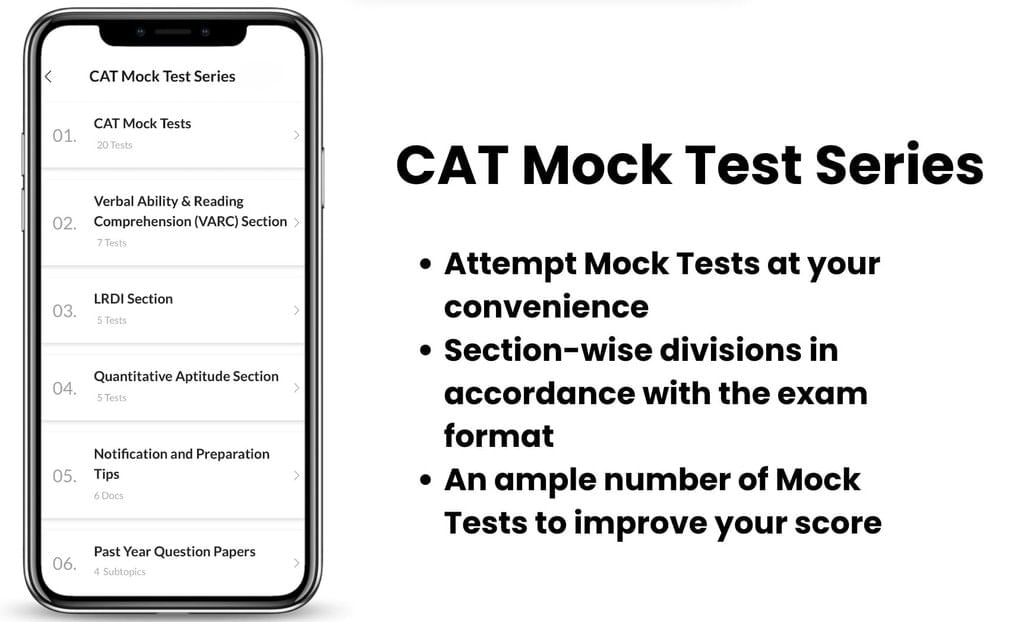CAT Bible: 11 Steps to Clear CAT Exam | Quantitative Aptitude (Quant) PDF Download
Why did EduRev make this guide on How to prepare for CAT?
- Cracking the CAT (Common Admission Test) requires not just hard work but a strategic, well-structured approach. With thousands of aspirants competing for a handful of top B-school seats, the difference between success and failure often comes down to planning, execution, and consistency.
- We wanted to answer the question "How to Prepare for CAT through self-study" once and for all in the best way possible.
- Students waste a large amount of time, effort, and money while preparing for the CAT just because of a lack of the right direction and guidance.

This guide is designed to be your one-stop resource for mastering the exam. Whether you're just starting or refining your strategy, these 11 steps will help you:
Understand the CAT exam structure and scoring pattern
Create a study plan tailored to your strengths and weaknesses
Master each section (VARC, DILR, QA) with targeted strategies
Optimise mock test performance and analyse mistakes effectively
Stay motivated and consistent throughout your preparation journey
No more guesswork or scattered advice—this guide gives you a clear, actionable roadmap to follow. If you’re ready to put in the effort, this guide will ensure that your preparation is focused, efficient, and result-oriented.
Let’s get started!
How was this guide made for the CAT Aspirants?
- This guide has been made by EduRev experts by referring to the strategies & interviews of the toppers, including Abhilasha Balakrishnan (99.86 %ile), Yogesh Taneja (100 %ile), and Rahul Gupta (100 %ile).
- Special thanks to Abhinav Gupta (IIM Kozhikode) and Ritika Jain (IIM A) for reviewing the final drafts.
Step-by-Step Preparation Strategy for CAT
This section aims to help you devise a well-planned preparation strategy for the upcoming CAT exam. Let’s have a look at the fool-proof STEP-by-STEP preparation strategy for preparing for the CAT exam.
Step 1: Understand the exam, make a mental plan and prepare yourself.
- Understand the exam pattern and syllabus: Although there's no defined CAT syllabus, but the EduRev team has done exhaustive research from previous years' papers & best books recommended by toppers and has compiled the detailed CAT syllabus, which you can read here.

- Make a Strategy & Time-table: A comprehensive plan needs to be in place before you start preparing for the exam. Whether you are a student or a working professional, you need to give at least 2 hours on a daily basis and devote a good amount of time on the weekends. If you are preparing on a daily basis, you should divide your time for preparing different sections in a balanced manner to cover the CAT Syllabus.
- Practice Vedic Maths to enhance your calculation speed: Practice Vedic Maths and start playing Sudoku, logic & puzzle games to boost your calculation speed for CAT.
- Start reading to develop reading speed: Go through novels, journals, or reputed magazines regularly to ace the verbal section smoothly.

- Improve your understanding of different topics: Go through various newspaper editorials & articles and try reading a diverse set of topics every day, which will improve your retention power and comprehension ability.
Step 2: Take a Mock Test to understand where you stand
- Give a Mock Test or a PYQ: It is highly recommended to attempt Previous Year Papers (PYQs) and Mock Tests to gain a clear understanding of the CAT Exam Pattern, including the types of questions, their structure, frequently asked topics, and overall format.

- Assess your strong and weak areas: After giving a mock test, you'll get a glimpse of your strengths and weaknesses. Start your preparation by keeping your strengths & weaknesses in consideration.
- Do not worry about the percentile in mocks initially: Since this is the first phase of your CAT preparation, you should not worry much about the performance in mocks or the percentile. The objective is to understand your strong & weak areas. It will improve gradually as you practice more tests and start preparing for each section independently.
EduRev provides All India Rank (AIR) & in-depth analysis after every test that you attempt. You also get to know the average time taken by the students across the country to attempt a particular question. Continuous analysis & improvement is really important for every CAT aspirant.
Step 3: Section-wise preparation: How to go about Quant, VARC & DILR Sections of CAT
Once you've understood your strengths & weaknesses and are done with Steps 1 & 2, it's time to start focusing on section-wise preparation. The CAT Exam is divided into 3 major sections, and as per the CAT Exam Pattern 2025:

The EduRev team has also compiled a section-wise strategy to ensure that you score a great percentile in the CAT exam.
Step 3.1: How to Prepare Quantitative Aptitude for CAT?
The Quantitative Aptitude section of the CAT Exam assesses a candidate’s mathematical skills, accuracy, and speed through numerical problems. Generally, the questions are based on basic and elementary mathematics, requiring a strong grasp of fundamental concepts for effective problem-solving.
"You have to realise that all questions carry equal weight, but some are easier. That should be the first step of your strategy: identifying what you can do best naturally."
- Learn the Basics of Mathematics by Heart: Candidates should thoroughly memorise multiplication tables, squares, and cubes, as these fundamental topics significantly aid in faster and more accurate calculations. Focus on learning squares of numbers from 1 to 30, cubes from 1 to 20, and multiplication tables from 1 to 20.
- Focus on clearing the basics first: Begin by building a strong foundation in the basic concepts. Start with simple examples to develop understanding, and then gradually progress to more challenging problems. Once you have conceptual clarity in each topic, consistently practice by solving a variety of questions. As your confidence grows, move on to sectional mock tests to assess your preparation and improve your performance. You can learn the basic concepts from the notes on EduRev, curated by IIM alumni, to improve your understanding of the topic from basics to advanced from here.
- Inculcate Important Formulas and Short Tricks while solving questions: You should understand that a long question that can be solved in 10 minutes can also be cracked with a trick within a few seconds; you need to master those important formulas & short tricks. EduRev has provided video lectures & detailed notes for all the topics, which help you understand such tricks with some quick examples. These are highly recommended for CAT Preparation, and you can get them in the Quantitative Aptitude (Quant).
- Improve your calculation speed: You can increase your calculation speed/skills by using various techniques, which you can learn through Vedic mathematics trick videos provided under the Quantitative Aptitude course on EduRev. It will help you to do basic calculations faster & remember square & cube roots, so you can attempt the questions faster.
- Brush up your basics of quant through NCERTs: If you're a beginner & think that you need to work on your basic mathematical skills and have an ample amount of time for the same, we recommend studying the basic NCERTs through this Maths NCERT for CAT on EduRev.
You can also find a detailed preparation strategy with the syllabus for Quant here. EduRev's team of experts has specifically designed this after researching the past year's papers, interacting with the toppers, and referring to the best books recommended by the toppers, to help you with Quant preparation for the CAT exam.
Step 3.2: How to prepare VARC (Verbal Ability & Reading Comprehension) for CAT?
The VARC section of the CAT exam comprises two sub-sections: Verbal Ability and Reading Comprehension. Among these, Reading Comprehension is often considered the more challenging component, as it can feature a wide range of topics and diverse question types. To perform well in this area, candidates should dedicate ample time to practising a variety of RC passages to build familiarity, comprehension skills, and accuracy.
So that you do not have to go through the hassle of searching for reading comprehension of different types, EduRev has prepared a 250 RC Course for you to practice.
Next, the Ability part is also as crucial as the RC. You can find quick videos & notes and multiple tests to practice for each topic in the Verbal Ability course on EduRev.
- Read as much as you can & increase your knowledge of topics: Every topper has emphasised that you should start reading newspapers and novels to prepare yourself for the RC section. It increases your reading speed, retention power, and comprehension ability by reading a diverse set of topics every day. Read as many articles as editorials as you can, or the Guardian or the Washington Post. This will also prepare you for GD's & PI's.
- Attempt RC-based tests and questions: First, read the questions and then read the passage. You tend to be alert in the passage around the part of the question automatically. You can start practising & mastering this skill by attempting different RC-based tests and questions from the RCs asked in previous year papers & which are available in the Reading Comprehension section in the EduRev course. It also provides video lectures & notes to help you understand the different RC-based questions asked in recent years.
You can attempt previous year RCs and can read a diversity of topics in RCs from the course on EduRev: 250 RCs for Practice - Improve your Vocabulary: Word Power Made Easy by Norman Lewis, is the go-to book to improve your vocabulary. It is not a book to be read but a book to work with daily to enrich your vocabulary using Word Lists. This book may or may not have a direct impact on your score for verbal ability, but it will ensure that you’re well-prepared for GDs, and PI's. You can find some helpful videos, notes & MCQ tests on Vocabulary here.
- Work on improving your Grammatical Skills: If you're a beginner, High School Grammar and Composition by Wren and Martin is a highly recommended book to help you create a strong base. EduRev has also provided a dedicated section of English Grammar & Grammar Tenses to help with the same. Each section provides interactive video lectures to help you understand the topic with detailed notes (& examples) and quick online MCQ tests.
- Practice Verbal Ability: You should practice a lot of questions to strengthen the topics of verbal ability and watch quick videos to understand the topic briefly & understand through examples. Spend more time practising a variety of topics.
- Converse with your friends in English: If you are weak in VARC, conversing in English with friends, and even watching English TV series and movies, will be helpful. Write down whatever new words you encounter after reading at least 5-6 newspaper articles every day.
For more information, you can also refer to: How to Prepare for VARC with EduRev.
Step 3.3: How to prepare DILR (Data Interpretation & Logical Reasoning) for CAT?
Data Interpretation is the process of analysing data using predefined methods to extract meaningful insights and draw relevant conclusions. It involves examining the results of data analysis, identifying relationships and patterns, and using these observations to make informed inferences.
Logical Reasoning involves aptitude-based questions that require analytical thinking and logical reasoning to arrive at the correct solution. While most questions are concept-driven, some demand out-of-the-box thinking and a creative approach to problem-solving.
Logical reasoning is classified into two types:
- Verbal Reasoning: It is the ability to logically understand concepts and solve problems expressed in words. Verbal reasoning tests the ability to extract information and implications in a sentence.
- Non-verbal Reasoning: It refers to the ability to logically understand concepts and solve problems involving numbers, letters, figures, and words. Non-verbal reasoning, in particular, assesses a candidate’s ability to use deductive and inductive logic to interpret information and identify underlying patterns or implications.
“I believe that the difficulty level of this section is usually overrated. I would start with the set that I’m most comfortable with and I would just read carefully and follow the instructions word-by-word. Next, I would try to follow my instincts, use hit and trial, make cases, and eliminate the erroneous ones. Again, practice is what did wonders here. Also, do not be scared of using that on-screen calculator, just make it a friend.” - Vishesh Garg (99.9 percentile)
- Start with basics: It is recommended to start with a generic topic like Pie Charts, Tables &Venn Diagrams & others. It helps you get tuned to the DILR Section from the perspective of how you start looking at data sets, and the conclusions you derive from them.
- Topic-wise Preparation: You should watch a few quick videos with examples and start practising the questions. Practice is what will make you really good at this section. You can watch topic-wise videos with examples and practice tests for each topic on EduRev.
- Practice Previous Year Papers & Mock Tests: You can start by practising the DILR section of the previous years' papers of different MBA entrance exams under the CAT Mock Test Series in the DILR course on EduRev.
- Data Interpretation (DI) is considered a bit more time-consuming. Start practising on Data Interpretation questions. Use approximation techniques for quick calculations.
We have prepared a detailed preparation strategy for 1DILR which you can access from How to Prepare for DILR with EduRev
"EduRev should be the first go-to app for every CAT aspirant. You get thousands of questions to practice including topic-wise & complete mock tests. Practice has been the only mantra to have worked in CAT exam for me. I cracked the exam after 5-months of the preparation." - Sazal Batra (IIM A)
Step 4: Practice, Practice & Practice: Topic-wise, Section-wise tests & PYQs
- Solving the CAT Previous Year Question Papers is very important for CAT Preparation. Practising topic-wise and section-wise tests will boost your confidence and help you prepare well.

- Attempt Section Wise & topic-wise tests: After covering the basic concepts of Quant, VARC & DILR. You should practice well by giving section-wise (Quant, VARC and DILR) & topic-wise tests.
- Attempt Previous Year Papers: You should also attempt the sectional & complete previous year papers to understand your analysis before the actual exam. You can refer to the Archives given in the courses of the different sections: Quantitative Aptitude, VARC & DILR. Also, the complete previous year's papers can be accessed from here.
Step 5: Start giving mocks at least 4 months before CAT
Four months is sufficient time to focus on mock test practice for the CAT exam. However, it's not the number of mock tests you take that matters—what truly counts is how effectively you analyse each test and use those insights to improve your performance.
- Attempt full-length Mock tests: You should attempt full mock tests from at least 2 sources, and can also refer to EduRev's Mock Test Series for CAT Exam, offering sectional & full mock tests. We recommend you attempt the mock tests through the EduRev website, because the actual CAT exam will be conducted on a computer system.

- Analysis is a must: After every CAT mock test, you must analyse your performance and evaluate your scoring areas based on the CAT question paper. The analysis of your mock CAT paper will bring clarity to your strengths and weaknesses.
The objective of these mock tests provided at EduRev is to prepare yourself for the actual CAT exam and improve your performance in every section before the exam. You can get real-time %ile and AIR whenever you attempt any test on EduRev, including all the Mock Tests. It helps you to constantly keep track of your performance.

- Focus on strength: Based on your self-evaluation, you should focus on strengthening your strong areas and building further expertise in them. Since most CAT questions are application-based, this is not the ideal stage to start learning entirely new concepts. Instead, concentrate your efforts on topics where you already have a good grasp and are able to solve questions with reasonable accuracy. Enhancing your command over these areas will yield better results.
Step 6: Revise all important questions & formulae (keep them handy)
Preparing for the CAT exam requires a lot of practice, but that practice won't be effective unless you know how to revise properly. No matter where you are in your CAT preparation, it's important to start planning your revision of the syllabus right away.
- Important Questions: There are some extraordinary questions (they're unique and not difficult) that make you go "Oh, I didn't think like that". There's no other way to solve such questions quickly apart from the technique mentioned in the solutions. So, having these questions on your tips is going to help you.
- Important Formulas: Needless to say, you need to revise the important formulas of each chapter. You will come across these formulas during:
- Reading the Basics
- Solving the Booklets
- Analysing the Mocks - Tricks and Shortcuts: When you look at the solutions of different questions you attempt through your books and mocks, you'll come across some interesting shortcuts. It is important to revise them.
- Books recommended for revision: Books that are recommended for the CAT Exam by toppers that you can refer to revise your concepts with examples:
- QA: Arun Sharma, Nishit K.Sinha
- VARC: Meenakshi Upadhayay & Arun Sharma
- DILR: Arun Sharma, Nishit K.Sinha
The EduRev course for the CAT Exam is designed based on these reference books and offers video lectures and notes for each topic. Each topic is explained clearly with multiple examples and is supported by several topic-wise tests for thorough practice.
Do you know that EduRev provides you an option to mark questions for review after you've attempted them? It helps you to create a collection of questions where you got stuck and revise them at the end.
Step 7: Analyse & Repeat Steps 4 to 6
After going from Step 4 to 6, analyse the areas where you are lacking and those where you have a stronghold.
- Revise the questions you have attempted well and practice weaker areas: Don’t forget to review the questions you answered correctly while attempting mock tests. This not only boosts your self-confidence but also helps reinforce your strengths for future attempts. At the same time, practise your weaker areas consistently until you gain complete command over them.
- Recognise the kind of mistakes you are making and correct them: Candidates commonly make three types of mistakes in the CAT exam: conceptual errors, silly calculation mistakes, and attempting questions that should have been avoided. After every mock test, it's essential to analyse the types of mistakes you’re repeatedly making and take focused steps to correct them.
- Sleep well and take care of your mental health: One important piece of advice for the final month before the exam is to prioritise good sleep. Rest plays a crucial role in improving accuracy, often more than additional test practice. Also, don’t neglect your mental well-being; staying calm and balanced is key to performing your best.
Step 8: One month before CAT
 Here are the things you should definitely follow in the last month before CAT:
Here are the things you should definitely follow in the last month before CAT:
- Frame a month's schedule in advance and adhere to it on a strict basis
Commit to studying at least 5–6 hours daily if you're a working professional, and 8–9 hours if you're a student. While planning your timetable, avoid focusing on just one section—ensure you allocate balanced time to all sections, with regular breaks to maintain consistency and avoid burnout. - Mocks, Mocks, Mocks – Put Quality over Quantity
Aim to take at least 10-12 mocks in the last month, at an average of 2-3 per week. Do not plan to take 30 mocks in the last month – that can be counter-productive. You should spend at least as much time reviewing a mock as you do in taking it. So, allow at least 3 hours for the review - Worry about accuracy a lot
You should aim for near 100% accuracy in Quant and DILR and upwards of 80% accuracy in VARC. Worrying about accuracy is an attitudinal change that you should make. - Revisit Fundamentals. It does help
Basics and fundamentals will help you prepare well. Revisit and revise them again and again in the last month before CAT. - Revise what you have learned. Do not go for new topics
Now is the time to get better at things that you are already good at and dump the things that you are poor at. Revise the stuff that you are comfortable with and forget about the topics that you hate. - Continue to read something every day
Reading habit matters. Read for an hour or so every day till the day of the CAT (and beyond). - Take care of yourself: Lastly, take care of yourself throughout the month. Take a breather between your perpetual studying hours and go for a drive, play a sport, or get enough hours of sleep.
Step 9: CAT Exam Day Plan/Strategy
Step 9.1: Before Exam:
- Sleep well the night before: To stay alert and focused during the CAT exam, it’s crucial to get a good night’s sleep beforehand. Aim for at least eight hours of rest the night before the exam to ensure your mind is calm and relaxed. A well-rested mind can significantly enhance your performance, especially in a test that demands strong calculation skills and logical reasoning.
- Reach the exam centre before reporting time: Reach your test centre at the time mentioned on the admit card for smooth and safe entry to the exam hall. Carry the CAT admit card and ID proof.
- Revise important formulae: On the night before the CAT exam, focus on revising important formulas, concepts, and theorems before you go to bed. Avoid starting any new topics or taking mock tests at this stage. Ideally, your preparation should be complete at least two weeks before the exam, allowing you to dedicate the final days solely to revision. Review your key concepts and go to sleep with a calm and confident mind.
- Avoid picking a new topic last minute: To avoid any confusion just before entering your CAT exam centre, avoid last-minute learning. Studying more is not equal to knowing more. So, don’t stretch and don’t stress. For a competitive exam like CAT, it is important that you prepare well throughout the year and not in the last few days or hours. Overall, well-structured exam preparation is the key.
Step 9.2: During Exam:
- Follow the exam pattern and your strategy: Throughout your CAT preparation journey, you have faced a lot of questions, and different CAT mock tests have helped shape your CAT day strategy. To avoid any panic situation, do not change your CAT day strategy or break your CAT exam-solving pattern. Follow the chronology:
- Verbal Ability and Reading Comprehension (VARC)
- Data Interpretation and Logical Reasoning (DILR) and
- Quantitative Aptitude (QA)
- Maintain your speed and accuracy: Be confident in your preparation. Keep yourself motivated with the thought that you have invested your time to crack this paper. Follow your strategy and maintain your speed and accuracy. Do not over-attempt or play the guessing game.
- How to attempt CAT on D-Day: For detailed knowledge on How to attempt CAT on D-Day go through this document, which will help you in making a perfect exam day strategy and will provide you with tips that must be followed on D-day.
Step 9.3: After Exam:
- Avoid after discussion: You have finished your paper. Come out of the centre and stay grounded. For your peace of mind do not discuss answers with your friends. This will help you stay calm even after the paper.
Step 10: Other Management Entrance Tests (OMET): XAT, NMAT & SNAP
Here is the list of other MBA entrance exams you can go for after going for CAT.
- XAT: XAT or Xavier Aptitude Test is an online CBT (computer-based) management entrance exam that grants the eligible candidate admission for MBA/PGDM courses offered by XLRI Jamshedpur, XIMB Bhubaneswar, SPJIMR Mumbai, IMT Ghaziabad, etc, along with 156 other management institutes in the country.
You can find the syllabus & strategy for the XAT exam here and the mock test series here. - NMAT: NMAT by GMAC is a national-level entrance test conducted for MBA admissions at NMIMS University and other reputed B-Schools in India as well as abroad.
You can find the syllabus & strategy for the NMAT exam here and the mock test series here. - SNAP: You can find the syllabus & strategy for the SNAP exam here and the mock test series here.
- CMAT: The Common Management Admission Test (CMAT) is a national-level, computer-based exam conducted by the National Testing Agency (NTA). It offers admission to MBA/PGDM programs in over 1,000 AICTE-approved B-schools, including JBIMS Mumbai, GIM Goa, and K J Somaiya Mumbai. Find the CMAT exam mock test series here.
- MAT: The Management Aptitude Test (MAT), conducted by AIMA, is a national-level exam for MBA/PGDM admissions in over 600 B-schools. It offers flexible testing modes (CBT, PBT, and IBT). Find the MAT exam mock test series here.
- MAH-CET: The Maharashtra Common Entrance Test (MAH-CET) is a state-level, computer-based exam for MBA/MMS admissions in Maharashtra’s B-schools, such as JBIMS, Sydenham, and Welingkar Mumbai. Find the MAH-CET exam mock test series here.
Step 11: Prepare for Interview, Group Discussion and WAT
Personal Interview (PI), Group Discussion (GD) and/or Written Ability Test (WAT) of the IIMs is a tough nut to crack, due to its unpredictable nature.
- You can prepare well for this round, going through all the current affairs, journals, business magazines, and newspaper editorials. It is important to remember that only knowledge is not enough; what you also need are personality traits like confidence, composure, and communication skills.
- Some of the parameters on which a candidate can be judged in the WAT-PI round: communication skills, writing ability, subject knowledge, listening power, confidence, leadership skills, presentation skills, interactive skills, decision-making ability, problem-solving ability, critical and analytical thinking, and open-mindedness
You can prepare for the interview in the best possible manner by following this course here.
Frequently Asked Questions (FAQs) related to How to Prepare for the CAT Exam
Q1. How often should I practise mock tests and sample questions?
Practice is the key to ace the CAT Exam. You can become more familiar with the exam pattern by taking mock tests regularly. They will also help you gain a better understanding of what to expect from the real exam and improve your speed. Once you are strong with the fundamentals, it is recommended to take one sectional mock every day, followed by an overall mock once every four days.
Q2. How to prepare for the Quantitative Aptitude section for CAT?
The QA section consists of about 22 questions. This section covers a variety of topics from Arithmetic, Algebra, Modern Maths, Geometry, Mensuration, etc. Set a timetable for your preparation beforehand. Prior to moving into the advanced topics, it is essential that you understand the fundamentals. Make it a habit to note the shortcuts and techniques that your mentors have taught you. Make best use of the past year papers to get better insights into this section.
Q3. How do I get a good percentile in Quants?
Practice is the key to attaining quantitative ability. More practice will help a student score well on the quant section. A detailed understanding of the CAT paper pattern, understanding the weightage of each topic is essential for CAT candidates. Getting a score of 99% on the CAT QA section requires an in-depth understanding of Arithmetic and Algebra.
Q4. How do I get a good percentile in DILR?
As for the CAT DILR section, 99 percentiles are achieved by selecting the correct sets to answer. This takes daily practice, so CAT aspirants must become habitual to solving at least 3-5 sets everyday. This will help aspirants become proficient in choosing the right type of sets, and solving them within the time-frame, without any hassle.
|
166 videos|229 docs|95 tests
|
FAQs on CAT Bible: 11 Steps to Clear CAT Exam - Quantitative Aptitude (Quant)
| 1. Why is it important to take a mock test before preparing for CAT? |  |
| 2. How can I effectively prepare for the VARC section of CAT? |  |
| 3. What should be my strategy for the DILR section? |  |
| 4. How often should I revise important questions and formulae during my preparation? |  |
| 5. When is the best time to start taking full-length mock tests? |  |






















